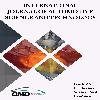Built-in Isolated Level 1 Unidirectional Battery Charger Design Aspects for a Small-Scale Electric Vehicle
Electric vehicles are increasing their place in the market with each passing day. The widespread use of this technology accelerates the development of sub-equipment in electric vehicles. Intensive studies are carried out for the develop-ment of many sub-equipment. One of the most important of these is the charging systems of electric vehicles. While electric vehicles are developing, charging systems are also developing rapidly in parallel. In this article, an integrated and isolated unidirectional lithium-ion battery charger design aspects has been im-plemented for a small-scale electric vehicle in three steps such as simulation, prototype and final product. As a result of the study, the prototype and final products are succeed on a 500 W DC load and the design aspects are demonstrat-ed.
Keywords:
Battery Charger, Electric Vehicle, Isolated Charger Lithium-Ion Battery, Unidirectional Battery Charger.,
___
- [1] M. Yilmaz and P. T. Krein, "Review of Battery Charger Topolo-gies, Charging Power Levels, and Infrastructure for Plug-In Elect-ric and Hybrid Vehicles," in IEEE Transactions on Power Electro-nics, vol. 28, no. 5, pp. 2151-2169, May 2013, doi: 10.1109/TPEL.2012.2212917.
- [2] A. Sharma and R. Gupta, "PV-Battery Supported Level-1 DC Fast charger for Electric Vehicles," 2019 IEEE Students Conference on Engineering and Systems (SCES), 2019, pp. 1-5, doi: 10.1109/SCES46477.2019.8977218.
- [3] Young-Joo Lee, A. Khaligh, and A. Emadi, “Advanced integrated bidirectional AC/DC and DC/DC converter for plug-in hybrid elec-tric vehicles,” IEEE Trans. Veh. Technol., vol. 58, no. 8, pp. 3970–3980, Oct. 2009.
- [4] B. Singh, B. N. Singh, A. Chandra, K. Al-Haddad, A. Pandey, and D. P. Kothari, “A review of three-phase improved power quality ac–dc converters,” IEEE Trans. Ind. Electron., vol. 51, no. 3, pp. 641–660, Jun. 2004.
- [5] S. Haghbin, K. Khan, S. Lundmark, M. Alak¨ula, O. Carlson, M. Leksell, and O. Wallmark, “Integrated chargers for EV’s and PHEV’s: Examples and new solutions,” in Proc. Int. Conf. Electri-cal Machines, 2010, pp. 1–6.
- [6] M. Grenier, M. H. Aghdam, and T. Thiringer, “Design of on-board charger for plug-in hybrid electric vehicle,” in Proc. Power Elec-tronics, Machine and Drives, 2010, pp. 1–6.
- [7] H. V. Nguyen and D. Lee, "Single-phase multifunctional onboard battery chargers with active power decoupling capability," 2018 IEEE Applied Power Electronics Conference and Exposition (APEC), 2018, pp. 3434-3439, doi: 10.1109/APEC.2018.8341597.
- [8] T. Soong and P. W. Lehn, "On-board Single-Phase Electric Vehi-cle Charger with Active Front End," 2018 International Power Electronics Conference (IPEC-Niigata 2018 -ECCE Asia), 2018, pp. 3203-3208, doi: 10.23919/IPEC.2018.8507547.
- [9] Y. Zhang et al., "Leakage Current Issue of Non-Isolated Integrated Chargers for Electric Vehicles," 2018 IEEE Energy Conversion Congress and Exposition (ECCE), 2018, pp. 1221-1227, doi: 10.1109/ECCE.2018.8558133.
- [10] H. V. Nguyen and D. Lee, "Advanced Single-Phase Onboard Chargers with Small DC-Link Capacitors," 2018 IEEE Internation-al Power Electronics and Application Conference and Exposition (PEAC), 2018, pp. 1-6, doi: 10.1109/PEAC.2018.8590400.
- [11] J. Gao, W. Sun, D. Jiang, Y. Zhang and R. Qu, "Improved Opera-tion and Control of Single-Phase Integrated On-Board Charger System," in IEEE Transactions on Power Electronics, vol. 36, no. 4, pp. 4752-4765, April 2021, doi: 10.1109/TPEL.2020.3025664.
- Yayın Aralığı: Yılda 4 Sayı
- Başlangıç: 2016
- Yayıncı: Otomotiv Mühendisleri Derneği
